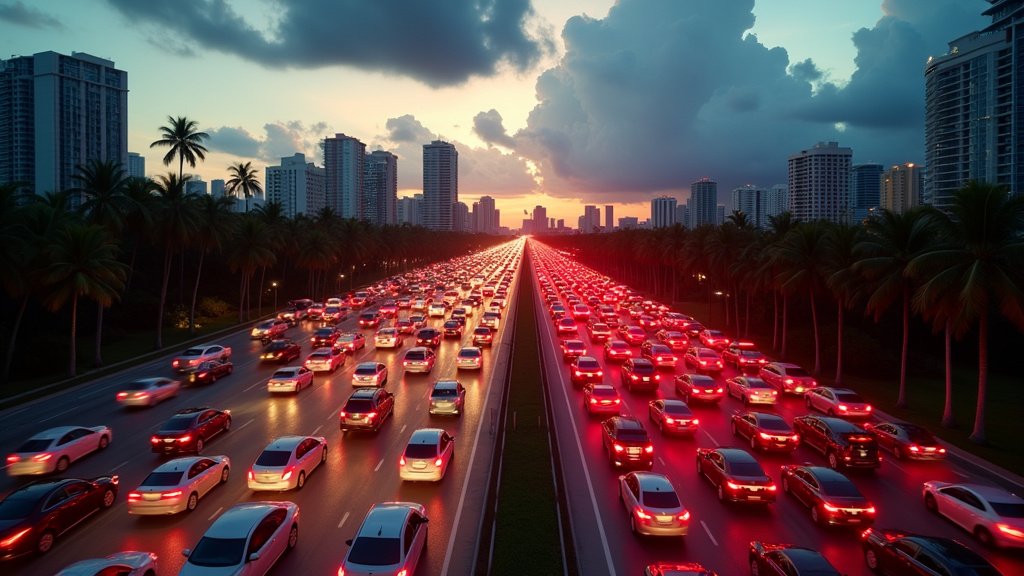Miami’s Gridlock: A Deep Dive into the Traffic Crisis, Its Roots, and the Quest for Solutions
Miami, a city renowned for its vibrant culture, stunning beaches, and economic dynamism, consistently grapples with a less glamorous distinction: persistent and often crippling traffic congestion. The daily grind on its roadways is a stark reality for residents and a jarring experience for newcomers, frequently prompting comparisons with urban environments elsewhere in the world. A Cuban woman who recently relocated from Spain, sharing her observations on TikTok, vividly highlighted the stark differences in driving culture, infrastructure, and the sheer volume of vehicles, underscoring a pervasive challenge that impacts every facet of life in the Magic City. [3, 7]
Traffic analytics firm INRIX has repeatedly placed Miami among the most congested cities globally and within the United States. While specific rankings fluctuate annually (e.g., 8th most congested globally in 2022, 10th in 2018), the underlying truth remains: Miamians spend an exorbitant amount of time stuck in traffic. In 2022, the average Miami driver lost an estimated 105 hours due to congestion, a 30% increase from pre-pandemic levels. [13, 21] More recently, some reports indicate drivers lost an average of 86 hours in 2024. [15] This isn’t merely an inconvenience; it carries a hefty price tag. The economic cost of congestion in Miami is estimated to exceed $3.6 billion annually, impacting businesses through delayed deliveries and increased transportation expenses, while also contributing to higher fuel consumption and pollution. [3, 4]
The Multifaceted Roots of Miami’s Traffic Woes
The causes behind Miami’s notorious gridlock are complex and deeply intertwined, stemming from a unique confluence of geographical, demographic, and historical factors.
Rapid Population Growth and Tourism: Miami’s allure as a hub for commerce, tourism, and culture has fueled explosive population growth. The Miami metropolitan area is home to over 6 million people, with the city’s population reaching approximately 3 million in 2024 and projected to hit 3.5 million by 2030. [4, 8, 23, 26] This influx of residents, coupled with a thriving tourism industry that sees Miami as the second-most visited city in the U.S. after New York City, overwhelms existing infrastructure. [2, 12, 26]
Geographic Constraints and Urban Sprawl: Miami-Dade County’s unique geography plays a significant role in limiting urban planning. Hemmed in by the Atlantic Ocean to the east and the protected Everglades National Park to the west, horizontal expansion is severely restricted. [10, 25, 35] This natural boundary pushes development inward and upward, increasing density, but also contributes to what some urban planners describe as a city resembling multiple smaller cities rather than a cohesive urban center. The legacy of automobile-centric development in the 20th century further cemented a sprawling urban design with long avenues and single-family homes, making efficient public transportation a challenge. [24]
Dominant Car Culture: Unlike many European cities, Miami embodies a deeply ingrained car culture. Approximately 8 out of 10 residents possess a driver’s license, and a staggering 90% commute by car. [7, 14] This reliance on personal vehicles is evident in driving habits, such as the frequent turning right on red (a practice less common in Spain) and a preference for larger, often customized, vehicles. [7] The need for a car is practically a necessity for many residents due to perceived deficiencies in public transportation. [7, 14]
Inadequate Infrastructure and Planning: While efforts are underway, Miami’s road infrastructure often struggles to keep pace with its growth. Problems include un-synced traffic lights that contribute to stop-and-go patterns and prolonged road construction projects that divert traffic onto already congested routes. [2, 6, 12] The phenomenon of induced demand, where expanding road capacity temporarily alleviates congestion only for it to return as more people choose to drive, poses a continuous challenge for urban planners. [12]
Public Transportation Gaps: Despite having a public transportation system that includes Metrorail, Metromover, and an extensive Metrobus network, its effectiveness is often debated. While some express satisfaction with its reach in specific corridors like Brickell and Downtown, others find it slow, unreliable, and lacking in coverage, particularly in lower-income communities and the outer fringes of the county. [19, 27, 30] The “first-mile, last-mile” problem—the challenge of connecting riders from their homes to transit stops—remains a significant barrier to widespread adoption. [38]
A Tale of Two Urban Philosophies: Miami vs. Europe
The experiences of those relocating from Europe often highlight a fundamental divergence in urban planning philosophies. In many Spanish and other European cities, public transportation, walkability, and cycling infrastructure are deeply integrated into the urban fabric, a product of centuries of dense, pedestrian-oriented development. Roundabouts, for instance, are far more prevalent in Spain than the numerous stop signs found in Miami, contributing to smoother traffic flow in certain contexts. [7]
Pedestrian courtesy is another striking contrast; in Europe, a stronger culture of deference to pedestrians often prevails. [7] Miami, while boasting some walkable neighborhoods like Downtown, Brickell, and Wynwood, often presents a fragmented pedestrian experience, with wide, busy roads and a perceived lack of safety for those on foot outside of specific areas. [16, 18, 19] One urban planning expert characterized Miami as “walkable urbanism for the rich and car dependency for everyone else,” pointing to disparities in pedestrian infrastructure between affluent and lower-income neighborhoods. [19]
The Quest for Solutions and a More Sustainable Future
Recognizing the profound impact of congestion on quality of life and economic vitality, Miami-Dade County is actively pursuing a range of strategies to address its traffic crisis.
Enhancing Public Transportation: Significant investments are being made to improve and expand public transit. The “Better Bus Network,” launched in November 2023, is the first redesign of bus routes in forty years, aiming for increased reliability and frequency, particularly benefiting low-income and minority residents. [36, 39] A $368 million Bus Rapid Transit corridor is set to roll out in early 2025. [14] Innovations like MetroConnect, an on-demand microtransit service, are addressing the crucial “first-mile, last-mile” gaps, with data suggesting it reduces private vehicle trips and lowers carbon emissions. [38]
Smart Infrastructure and Urban Planning: Modern transportation management systems, employing real-time monitoring, predictive analytics, and adaptive traffic signal control, are being explored to optimize traffic flow. [3] Urban planning initiatives, such as the Miami21 zoning code, promote compact, mixed-use developments and Transit-Oriented Developments (TODs) around major transit stations to foster walkability and reduce car dependence. [20] There’s also a push to create job and entertainment hubs in western and southern parts of the county to alleviate eastbound commuting congestion. [15]
Infrastructure Upgrades and Technological Integration: The Florida Department of Transportation’s “Moving Florida Forward” initiative allocates $4 billion for major roadway improvements, including projects at the Golden Glades Interchange. [13] Additionally, there is a focus on syncing traffic lights across the city for more efficient flow [6], and even exploring artificial intelligence for improved incident detection and response. [13]
While the challenges are immense, with population growth continuing and the phenomenon of induced demand often counteracting road expansion efforts, Miami is at a critical juncture. The shift towards micro-mobility options among younger generations, alongside ongoing public and private sector collaborations, offers a glimmer of hope for a future where navigating Miami’s vibrant landscape becomes less of a headache and more of an enjoyable experience for all. [12, 13]





